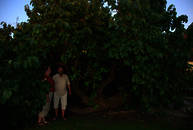Traditional orchards in Denmark
Danish orchard tradition begins in the early 1800s. Pastor Bjerregaard, clergyman in Hjermind (1795-1855) and Jeremias Wøldike, clergyman in Ø. Hornum (1860-1879) were two pioneers, teaching the Danish to cultivate fruit. Around 1800, the royal fruit tree nursery was started in order to enhance fruit-growing, something that did not really happen until 100 years later, when private nurseries like Mathiesen in Skælskør, Bøgh in Horsens and Brostrøm in Viborg with a wide selection of fruit trees and fruit berries were established.
From 1800 to about 1920 many new Danish apple varieties appeared. It was commonplace to believe, that a seed from one apple would result into an apple tree identical to the one the seed originally came from. Best known are the varieties Filippa and Ingrid Marie. About 1950 in Danish orchards there were about 1,000 different varieties. Between 1900 and 1950, an increase in apple farming led to disregard or even neglect of other fruit species, such as pears, plums and fruit berries.
The death of many apple varieties
Roughly 1950, the decision was taken, to decrease the number of varieties to about 20 different apples. This lead into the death of many apple varieties and thus decreasing numbers of orchards, planted between 1860 and the 1920s. It is considered a paradox, that shortly after its decision to reduce the total number of apple varieties, Denmark imported 10-15 new varieties from the USA, which were widely grown until the 1970s.
Following Denmark's accession to the EEC in 1972, subsidies for the removal of fruit trees caused further decline in the total number of orchards; only few and bigger orchards remained; smaller orchards with different fruit types almost disappeared.
Over the past ten years, Denmark has noticed an increasing interest for older apple varieties; a growing market presents demand for small orchards with self-picking or direct marketing facilities. A changed culture presents growing interest in niche productions, such as fruit wine, cider, fruit syrup and other forms of processed fruit.
Globalisation as an eye-opener
At the same time, there are attempts to resume with the production of some of the fruit products, common in Denmark 60-100 years ago.
Increasing globalisation was an eye-opener, convincing the Danish that fruit can be much more than just fresh fruit. Denmark is on its way becoming a wine-producing country; processing home-grown fruit is no longer out of fashion.
Over the past 40-50 years, the production in large orchards has been aligned with current practice. To Denmark, organic orchards are a fairly new concept and thus a slow starter. Knowledge, on how different varieties can perform without spraying, is limited. In recent years, only a few plantations completely lacking insecticides and fungicides, were introduced, among those Blomstergården and Dansk Landbrugsmuseum.










